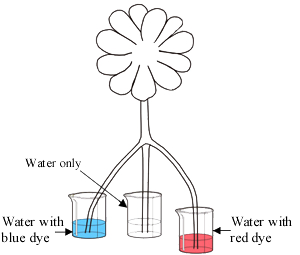Shasta daisy and dye
This task is about conducting an investigation, and making and explaining observations.
How to do this task:
- The flower you have been given is a shasta daisy.
- Split the bottom third of the stem lengthwise into three sections.
- Place one section of the stem in a 100 mL beaker half full of water.
- Place another section of the stem in a 100 mL beaker half full of water plus 2 drops of red food colouring.
- Place the third section of the stem in a 100 mL beaker half full of water plus 2 drops of blue food colouring.
- Leave this set-up for 24 hours. (See diagram below.)
 |
|

